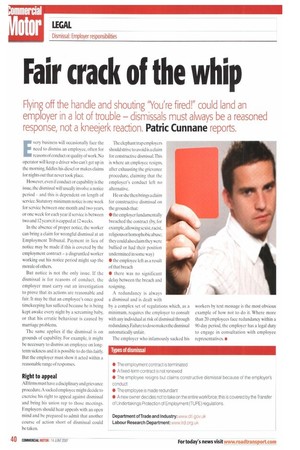Fair crack of the whip
Page 40

If you've noticed an error in this article please click here to report it so we can fix it.
Flying off the handle and shouting "You're fired!" could land an employer in a lot of trouble — dismissals must always be a reasoned response, not a kneejerk reaction. Patric Cunnane reports.
Every business will occasionally face the need to dismiss an employee, often for reasons of conduct or quality of work. No operator will keep a driver who can't get up in the morning, fiddles his diesel or makes claims for nights out that never took place.
However, even if conduct or capability is the issue, the dismissal will usually involve a notice period — and this is dependent on length of service. Statutory minimum notice is one week for service between one month and two years, or one week for each year if service is between Iwo and 12 years; it is capped at 12 weeks.
In the absence of proper notice, the worker can bring a claim for wrongful dismissal at an Employment Tribunal. Payment in lieu of notice may he made if this is covered by the employment contract — a disgruntled worker working out his notice period might sap the morale of others.
But notice is not the only issue. If the dismissal is for reasons of conduct, the employer must carry out an investigation to prove that its actions are reasonable and fair. It may be that an employee's once good timekeeping has suffered because he is being kept awake every night by a screaming baby, or that his erratic behaviour is caused by marriage problems.
The same applies if the dismissal is on grounds of capability. For example, it might be necessary to dismiss an employee on longterm sickness and it is possible to do this fairly. But the employer must show it acted within a reasonable range of responses.
Right to appeal All I irms must have a disciplinary and grievance procedure.A sacked employee might decide to exercise his right to appeal against dismissal and bring his union rep to those meetings. Employers should hear appeals with an open mind and be prepared to admit that another course of action short of dismissal could be taken. The elephant trap employers should strive to avoid is a claim for constructive dismissal.This is where an employee resigns, after exhausting the grievance procedure, claiming that the employer's conduct left no alternative.
He or she then brings a claim for constructive dismissal on the grounds that: • the employer fundamentally breached the contract (by, for example, allowing sexist,racist, religious or homophobic abuse; they could also claim they were bullied or had their position undermined in some way) • the employee left as a result of that breach • there was no significant delay between the breach and resigning.
A redundancy is always a dismissal and is dealt with by a complex set of regulations which, as a minimum, requires the employer to consult with any individual at risk of dismissal through redundancy. Failure to dos° makes the dismissal automatically unfair.
The employer who infamously sacked his workers by text message is the most obvious example of how not to do it. Where more than 20 employees face redundancy within a 90-day period, the employer has a legal duty to engage in consultation with employee representatives. •


























































































































































































